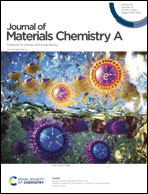Positive regulation of active sites for oxygen evolution reactions by encapsulating NiFe2O4 nanoparticles in N-doped carbon nanotubes in situ to construct efficient bifunctional oxygen catalysts for rechargeable Zn–air batteries†
Abstract
In this work, a bifunctional oxygen catalyst containing both spinel structure sites and nitrogen doping sites was prepared based on a directional regulation strategy by adding Ni(OH)2 into a Fe3+–melamine precursor and then pyrolyzing the mixture. Melamine was pyrolyzed into N-doped carbon nanotubes, which afford oxygen reduction reaction (ORR) active sites, and meanwhile, the generated NiFe2O4 particles can act as active components for oxygen evolution reactions (OERs). The as-prepared catalyst named Fe–Me–Ni exhibits excellent bifunctional activities for ORRs with a half-wave potential of 0.841 V, and for OERs with an overpotential of 313 mV at 10 mA cm−2. The Zn–air battery fabricated from Fe–Me–Ni can work at a discharge voltage of 1.23–1.28 V with a specific capacity of 798 mA h gZn−1 at 10 mA cm−2, outperforming those of the Pt/C + RuO2 catalyst (1.17–1.24 V, 787 mA h gZn−1). The battery evaluation results also indicate the remarkable rechargeability and long-term cycling stability of the catalyst Fe–Me–Ni in practical applications.



 Please wait while we load your content...
Please wait while we load your content...